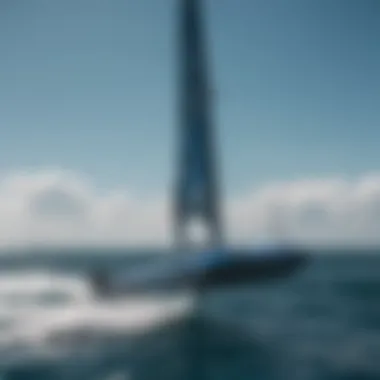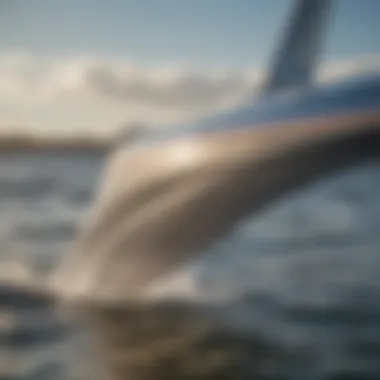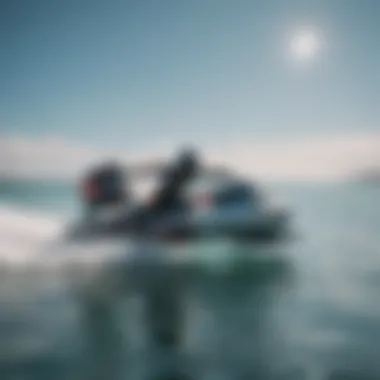Unveiling the Intricacies of Hydrofoil Parts: A Comprehensive Guide for Passionate Kitesurfers


Equipment Reviews
When it comes to kitesurfing and enhancing the riding experience, having the right equipment is paramount. Starting with the kites, there are various models available, each with unique features and performance attributes. Understanding aspects like kite shapes, sizes, materials, and brands can significantly impact one's kitesurfing adventures. Moving on to boards, riders have a choice between twintips and directional boards, each designed with specific considerations in mind. Evaluating factors such as design, construction, and riding style suitability is crucial for optimal performance on the water. Additionally, exploring essential kiteboarding accessories like harnesses, lines, pumps, and safety gear is essential. Discussing the importance of each accessory can help kitesurfing enthusiasts prepare adequately for their rides.
Introduction to Hydrofoils
Hydrofoils are a critical component for kitesurfing enthusiasts as they significantly impact the riding experience. Understanding the intricate design and functionality of hydrofoils is essential for achieving optimal performance and stability while gliding over the water. In this comprehensive guide, we will delve deep into the various elements that constitute a hydrofoil setup, from the mast to the stabilizer.
Understanding Hydrofoil Anatomy
The Mast
The mast is a fundamental part of the hydrofoil setup, serving as the vertical element that connects the foil to the board. Its length, material, and connection type all play crucial roles in determining the hydrofoil's performance in the water. Aluminum masts are popular for their lightweight characteristics, offering a good balance between strength and weight. They are known for their rigidity, which enhances stability during kitesurfing maneuvers. However, aluminum masts may be prone to corrosion over time, requiring regular maintenance to ensure longevity.
The Fuselage
The fuselage acts as the intermediary component that connects the mast to the wings of the hydrofoil. Its length and material composition influence the overall maneuverability and response of the hydrofoil. Carbon fiber fuselages are favored for their high strength-to-weight ratio, providing durability without compromising agility. The sleek design of carbon fiber fuselages reduces drag in the water, improving speed and efficiency for the rider. However, carbon fiber fuselages may come at a higher cost compared to other materials.
The Front Wing
The front wing is a key element responsible for generating lift and stability while kitesurfing. Its design, including aspect ratio and wing profile, influences the overall performance of the hydrofoil. High aspect ratio front wings offer increased lift and efficiency, suitable for riders seeking fast speeds and smooth gliding experiences. However, high aspect ratio wings may require higher speeds to generate lift, making them more suitable for advanced riders.
The Rear Wing
The rear wing complements the front wing by providing balance and controlling the hydrofoil's pitch. Its size, shape, and distance from the front wing impact the handling and stability of the hydrofoil. Anhedral rear wings, with a downward angle from the fuselage, enhance stability and control during carving and edging maneuvers. However, anhedral rear wings may produce more drag compared to flat or dihedral designs, affecting speed and efficiency.
The Stabilizer
The stabilizer, also known as the tail wing, plays a crucial role in maintaining balance and preventing the hydrofoil from yawing uncontrollably. Its shape and positioning relative to the front wing affect the responsiveness and agility of the hydrofoil. Inverted T-shaped stabilizers are commonly used for their balanced performance, offering a combination of stability and maneuverability. However, inverted T-shaped stabilizers may exhibit increased drag at higher speeds, impacting overall efficiency in certain kitesurfing conditions.
Importance of Hydrofoil Parts
Aerodynamics in Performance
Aerodynamics play a vital role in determining the overall performance of a hydrofoil setup. The design of each component, from the mast to the wings, influences how air flows over the foil during kitesurfing. By optimizing aerodynamics, riders can experience enhanced lift, reduced drag, and improved maneuverability on the water. Choosing hydrofoil parts with streamlined profiles and efficient airfoil shapes can maximize performance while minimizing energy expenditure, enabling riders to navigate through varying wind conditions with ease.
Stability and Control
Stability and control are paramount when kitesurfing with a hydrofoil, as even minor adjustments can greatly impact riding experience. The design of the mast, wings, and stabilizer directly affects the hydrofoil's ability to maintain a steady course and respond to rider input. Components that prioritize stability and control offer riders a sense of confidence and predictability on the water, allowing for seamless transitions between different maneuvers and wind conditions. Striking a balance between stability and maneuverability is key to optimizing control and enhancing the overall kitesurfing experience.
B Impact on Riding Experience


The choice of hydrofoil parts directly influences the overall riding experience for kitesurfing enthusiasts. Factors such as wing design, fuselage length, and stabilizer shape can determine how effortlessly a rider can glide over the water and perform various maneuvers. By selecting hydrofoil parts that align with their skill level, riding style, and prevailing wind conditions, riders can tailor their setup to suit their preferences and enhance their enjoyment on the water. Investing in high-quality hydrofoil parts that offer a harmonious blend of performance and comfort can elevate the kitesurfing experience to new heights.
Key Components of a Hydrofoil Setup
When delving into the world of hydrofoil parts, understanding the key components of a hydrofoil setup becomes paramount for kitesurfing enthusiasts looking to elevate their riding experience. The mast, wings, fuselage, and stabilizer all play vital roles in ensuring optimal performance and stability on the water. Each component works in harmony to provide lift, control, and balance, making them crucial elements in the kitesurfing experience.
The Mast: Backbone of the Hydrofoil
The mast serves as the backbone of the hydrofoil setup, influencing the overall stability and performance of the ride.
Mast Length
Mast Length is a critical aspect to consider when choosing a hydrofoil setup. The length of the mast affects the height at which the board rides above the water, impacting maneuverability and speed. A longer mast allows for greater clearance between the board and the water, enabling tighter turns and reducing drag. However, a longer mast may also require more skill to handle effectively, especially in choppy conditions where stability is key.
Mast Material
The choice of material for the mast is essential in determining its strength, weight, and durability. Materials like aluminum, carbon fiber, or titanium are popular choices due to their lightweight properties and resistance to corrosion. Carbon fiber, in particular, is favored for its high strength-to-weight ratio, providing optimal performance while reducing overall weight for enhanced maneuverability.
Mast Connection
The mast connection plays a crucial role in ensuring a secure attachment between the mast and the board. A solid mast connection minimizes vibrations and wobbling during the ride, enhancing stability and control. Adjustable mast connections offer the flexibility to fine-tune the hydrofoil setup according to the rider's preferences and riding conditions, allowing for personalized performance optimization.
The Wings: Core Elements of Lift
The wings of a hydrofoil setup are fundamental in generating lift and controlling the ride.
Front Wing Design
The design of the front wing directly impacts the lift and stability of the hydrofoil. Different shapes and sizes of front wings cater to varying riding styles and conditions. A larger front wing provides more lift, ideal for beginners or lighter wind conditions, while a smaller front wing offers increased speed and maneuverability for experienced riders in stronger winds. The angle of attack and curvature of the front wing also contribute to lift and efficiency in the water.
Rear Wing Functionality
The rear wing complements the front wing by balancing the forces acting on the hydrofoil. The size and shape of the rear wing influence the stability and maneuverability of the board. A larger rear wing enhances stability and control, making it suitable for riders seeking a more relaxed and predictable ride. Conversely, a smaller rear wing promotes agility and responsiveness, ideal for advanced riders looking to perform tricks and turns with precision.
The Fuselage: Connecting the Dots
The fuselage of a hydrofoil setup serves as the junction that connects the mast, wings, and board together, ensuring coherence and efficiency in the ride.
Fuselage Length
The length of the fuselage impacts the hydrodynamics and stability of the board. A longer fuselage provides increased stability and smoother rides, making it suitable for beginners or riders focusing on cruising at lower speeds. Alternatively, a shorter fuselage reduces drag and enhances maneuverability, ideal for riders seeking more dynamic and responsive performances.
Fuselage Material


The material of the fuselage influences its strength, weight, and corrosion resistance. Aluminum and carbon fiber are popular choices for fuselages due to their durability and lightweight properties. Carbon fiber fuselages offer the advantage of high stiffness and strength, translating to improved responsiveness and performance on the water.
The Stabilizer: Ensuring Balance
The stabilizer plays a crucial role in maintaining balance and preventing pitch or roll movements during the ride.
Stabilizer Shape
The shape of the stabilizer directly affects the stability and control of the hydrofoil. Different stabilizer shapes cater to various riding styles and preferences. A wider and more squared stabilizer offers enhanced stability, making it an excellent choice for riders focusing on cruising and carving. In contrast, a narrower and more tapered stabilizer provides increased agility and responsiveness, allowing for sharper turns and maneuvers.
Stabilizer Positioning
The positioning of the stabilizer relative to the wings influences the overall handling and performance of the hydrofoil. Adjusting the stabilizer angle and distance from the wings allows riders to fine-tune the balance and responsiveness of the board according to their preferences. A more forward position enhances stability and tracking, while a rearward position promotes maneuverability and speed, offering riders versatility in adapting to different riding conditions.
Choosing the Right Hydrofoil Parts
Choosing the right hydrofoil parts is a critical aspect of enhancing kitesurfing experiences. Hydrofoils are complex systems consisting of various components like the mast, wings, fuselage, and stabilizer. Each part contributes uniquely to the overall performance and stability of the hydrofoil setup. Selecting the appropriate parts tailored to individual preferences and kitesurfing conditions can significantly impact the rider's overall enjoyment and progress. By understanding the key elements and functionalities of hydrofoil parts, riders can make informed decisions that align with their skill level, riding style, and local wind conditions.
Factors to Consider
Skill Level
Skill level is a pivotal factor in choosing the right hydrofoil parts. Riders at different proficiency levels require varying characteristics in their hydrofoil setup. Novice riders may benefit from stable and easy-to-control foils to aid in the learning process, while advanced riders may seek high-performance components for dynamic maneuvers. Understanding one's skill level is crucial in determining the optimal combination of mast length, wing design, and stabilizer shape for a balanced and rewarding kitesurfing experience.
Wind Conditions
Wind conditions play a significant role in selecting hydrofoil parts. Depending on the prevailing wind strength and direction in a particular kitesurfing location, riders need to consider the aerodynamic properties of their foils. Choosing wings and stabilizers that complement the wind conditions can enhance lift, speed, and overall control during rides. Riders must adapt their hydrofoil setup to suit varying wind patterns to optimize performance and maximize time on the water.
Riding Style
Riding style is another key consideration when choosing hydrofoil parts. Whether riders prefer freestyle tricks, speed-focused runs, or long-distance cruising, the hydrofoil setup can be customized to align with individual riding preferences. Different wing designs, mast materials, and fuselage lengths cater to diverse riding styles, allowing riders to personalize their equipment for a bespoke kitesurfing experience. Adapting the hydrofoil configuration to suit one's riding style ensures a seamless connection between the rider and the water, making each session more enjoyable and fulfilling.
Customization Options
Adjustable Components
Adjustable components offer versatility and adaptability in hydrofoil setups. Riders can fine-tune parameters such as wing angles, fuselage connections, and stabilizer positioning to optimize performance based on changing conditions or evolving skill levels. The ability to adjust key components provides riders with dynamic control over their hydrofoil system, empowering them to explore different riding techniques and refine their overall kitesurfing skills.
Interchangeable Parts
Interchangeable parts facilitate quick and convenient modifications to the hydrofoil configuration. Riders can easily swap out wings, fuselages, or stabilizers to experiment with new setups or tailor their foils to specific riding environments. Having interchangeable parts in a hydrofoil setup offers flexibility and customization options, allowing riders to adapt to various water conditions and performance demands effortlessly. The versatility of interchangeable parts enhances the rider's ability to adapt and excel in diverse kitesurfing scenarios.
Maintenance and Care Tips


Maintenance and care of your hydrofoil are vital to ensure optimal performance and longevity. Neglecting these aspects can lead to decreased efficiency and potential damage to your equipment. By following proper maintenance routines, you can extend the lifespan of your hydrofoil and enjoy a smoother kitesurfing experience.
Cleaning and Storage
Rinsing After Use
Rinsing your hydrofoil after each session is crucial in preventing saltwater and debris buildup. This simple yet effective step helps maintain the integrity of the materials and prevents corrosion. By thoroughly rinsing all components, especially the wings and fuselage, you can ensure that your hydrofoil stays in top condition for longer periods. Additionally, rinsing after each use reduces the risk of damage and enhances the overall performance of your equipment.
Drying Before Storage
Properly drying your hydrofoil before storage is essential to prevent mold, mildew, and oxidation. After rinsing, allow all parts to air dry completely before assembling or storing them. Ensuring that there is no residual moisture trapped in the components helps prevent rust and deterioration. By incorporating this step into your post-ride routine, you contribute to the preservation of your hydrofoil's components and maintain peak performance.
Regular Inspection
Regularly inspecting your hydrofoil for wear and tear is key to detecting issues early and addressing them promptly. Checking for any signs of damage such as cracks, dents, or loose fittings can prevent catastrophic failures while on the water. By conducting routine inspections, you can identify potential problems before they escalate and take necessary measures to avoid accidents and prolong the life of your hydrofoil.
Check for Damage
Inspecting all parts of your hydrofoil, including the mast, wings, fuselage, and stabilizer, for any visible damage is imperative. Look for scratches, chips, or any structural inconsistencies that may compromise performance or safety. By paying attention to the condition of your equipment, you can make timely repairs or replacements, ensuring that your hydrofoil remains in top shape for your next session.
Tighten Connections
Checking and tightening all connections and fasteners regularly is essential for maintaining stability and safety while riding. Loose bolts or screws can affect the performance of your hydrofoil and pose a risk of disassembly during use. By verifying the tightness of all components, you minimize the chances of accidents and uphold the structural integrity of your setup.
Preventative Maintenance
Incorporating preventative maintenance measures into your routine is a proactive approach to caring for your hydrofoil.
Use Protective Covers
Utilizing protective covers for your hydrofoil components when not in use shields them from external elements and physical damage. Covering the wings, mast, and fuselage with appropriate protective gear safeguards against scratches, UV exposure, and impacts that could compromise their performance. By investing in protective covers and consistently using them, you significantly extend the lifespan of your hydrofoil and maintain its aesthetic appeal.
Store in Safe Location
Storing your hydrofoil in a secure and suitable environment is crucial for its preservation and functionality. Choosing a designated storage area that is dry, well-ventilated, and away from direct sunlight or extreme temperatures helps prevent degradation of materials. By storing your hydrofoil properly, you protect it from unnecessary wear and tear, ensuring that it retains its quality and performance characteristics over time.
Conclusion
In the realm of hydrofoil parts for kitesurfing enthusiasts, the conclusion serves as a crucial segment that consolidates the essence of optimizing one's hydrofoil setup. Through continuous learning and experimentation, riders embark on a journey of refining their skills and honing their techniques for enhanced performance on the water. This commitment to ongoing improvement is the cornerstone of progression in the kitesurfing world, fostering a deeper connection between the rider and the sport. By embracing professional advice, individuals can glean valuable insights from experts in the field, gaining access to refined strategies and tailored recommendations that propel their kitesurfing endeavors to new heights. Seeking professional advice not only accelerates skill development but also nurtures a sense of community within the kitesurfing ecosystem, where shared knowledge and experiences enrich the collective understanding of hydrofoil dynamics and riding techniques.
Optimizing Your Hydrofoil Setup
Continuous Learning and Experimentation
Delving into the intricacies of continuous learning and experimentation illuminates a fundamental practice in the domain of hydrofoil kitesurfing. By engaging in continuous learning, enthusiasts embrace a growth mindset that thrives on exploration and adaptation. This proactive approach not only enhances technical proficiency but also cultivates resilience and creativity in navigating varying water conditions and challenging terrains. Experimentation, on the other hand, empowers riders to push boundaries and discover innovative ways to harness the power of hydrofoil technology effectively. By experimenting with different setups and configurations, kitesurfers can personalize their riding experience, uncovering hidden potentials and refining their skills with each new iteration.
Seeking Professional Advice
The quest for seeking professional advice emerges as a pivotal strategy in optimizing one's hydrofoil setup for kitesurfing pursuits. Professional advice offers a wealth of insights and perspectives from seasoned experts, guiding enthusiasts towards informed decision-making and strategic advancements in their riding techniques. The exchange of knowledge and expertise between professionals and riders fosters a collaborative environment that nurtures growth and proficiency within the kitesurfing community. While seeking professional advice enhances technical competency and performance optimization, it also instills a sense of camaraderie and solidarity among kitesurfing aficionados, strengthening the fabric of the sport and propelling innovation in hydrofoil design and functionality.







